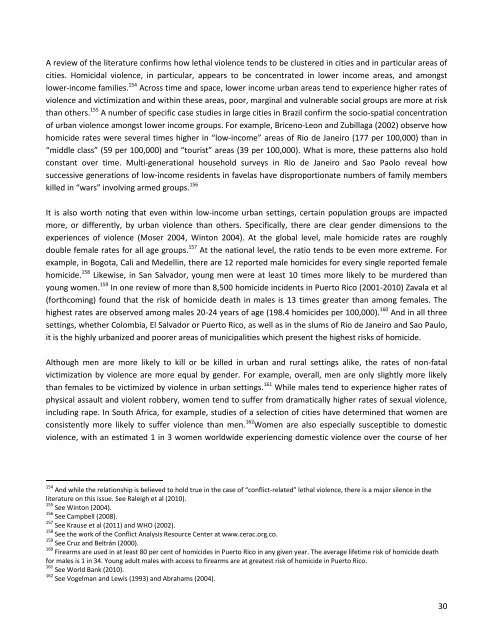Researching-the-Urban-Dilemma-Baseline-study
Researching-the-Urban-Dilemma-Baseline-study
Researching-the-Urban-Dilemma-Baseline-study
You also want an ePaper? Increase the reach of your titles
YUMPU automatically turns print PDFs into web optimized ePapers that Google loves.
A review of <strong>the</strong> literature confirms how lethal violence tends to be clustered in cities and in particular areas of<br />
cities. Homicidal violence, in particular, appears to be concentrated in lower income areas, and amongst<br />
lower-income families. 154 Across time and space, lower income urban areas tend to experience higher rates of<br />
violence and victimization and within <strong>the</strong>se areas, poor, marginal and vulnerable social groups are more at risk<br />
than o<strong>the</strong>rs. 155 A number of specific case studies in large cities in Brazil confirm <strong>the</strong> socio-spatial concentration<br />
of urban violence amongst lower income groups. For example, Briceno-Leon and Zubillaga (2002) observe how<br />
homicide rates were several times higher in “low-income” areas of Rio de Janeiro (177 per 100,000) than in<br />
“middle class” (59 per 100,000) and “tourist” areas (39 per 100,000). What is more, <strong>the</strong>se patterns also hold<br />
constant over time. Multi-generational household surveys in Rio de Janeiro and Sao Paolo reveal how<br />
successive generations of low-income residents in favelas have disproportionate numbers of family members<br />
killed in “wars” involving armed groups. 156<br />
It is also worth noting that even within low-income urban settings, certain population groups are impacted<br />
more, or differently, by urban violence than o<strong>the</strong>rs. Specifically, <strong>the</strong>re are clear gender dimensions to <strong>the</strong><br />
experiences of violence (Moser 2004, Winton 2004). At <strong>the</strong> global level, male homicide rates are roughly<br />
double female rates for all age groups. 157 At <strong>the</strong> national level, <strong>the</strong> ratio tends to be even more extreme. For<br />
example, in Bogota, Cali and Medellin, <strong>the</strong>re are 12 reported male homicides for every single reported female<br />
homicide. 158 Likewise, in San Salvador, young men were at least 10 times more likely to be murdered than<br />
young women. 159 In one review of more than 8,500 homicide incidents in Puerto Rico (2001-2010) Zavala et al<br />
(forthcoming) found that <strong>the</strong> risk of homicide death in males is 13 times greater than among females. The<br />
highest rates are observed among males 20-24 years of age (198.4 homicides per 100,000). 160 And in all three<br />
settings, whe<strong>the</strong>r Colombia, El Salvador or Puerto Rico, as well as in <strong>the</strong> slums of Rio de Janeiro and Sao Paulo,<br />
it is <strong>the</strong> highly urbanized and poorer areas of municipalities which present <strong>the</strong> highest risks of homicide.<br />
Although men are more likely to kill or be killed in urban and rural settings alike, <strong>the</strong> rates of non-fatal<br />
victimization by violence are more equal by gender. For example, overall, men are only slightly more likely<br />
than females to be victimized by violence in urban settings. 161 While males tend to experience higher rates of<br />
physical assault and violent robbery, women tend to suffer from dramatically higher rates of sexual violence,<br />
including rape. In South Africa, for example, studies of a selection of cities have determined that women are<br />
consistently more likely to suffer violence than men. 162 Women are also especially susceptible to domestic<br />
violence, with an estimated 1 in 3 women worldwide experiencing domestic violence over <strong>the</strong> course of her<br />
154 And while <strong>the</strong> relationship is believed to hold true in <strong>the</strong> case of “conflict-related” lethal violence, <strong>the</strong>re is a major silence in <strong>the</strong><br />
literature on this issue. See Raleigh et al (2010).<br />
155 See Winton (2004).<br />
156 See Campbell (2008).<br />
157 See Krause et al (2011) and WHO (2002).<br />
158 See <strong>the</strong> work of <strong>the</strong> Conflict Analysis Resource Center at www.cerac.org.co.<br />
159 See Cruz and Beltrán (2000).<br />
160 Firearms are used in at least 80 per cent of homicides in Puerto Rico in any given year. The average lifetime risk of homicide death<br />
for males is 1 in 34. Young adult males with access to firearms are at greatest risk of homicide in Puerto Rico.<br />
161 See World Bank (2010).<br />
162 See Vogelman and Lewis (1993) and Abrahams (2004).<br />
30




